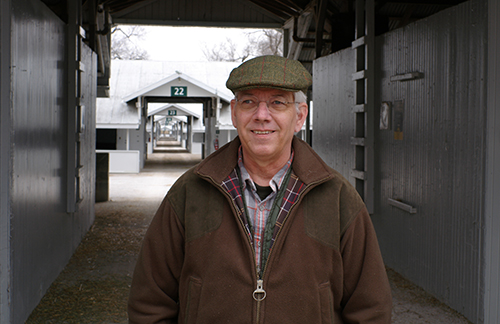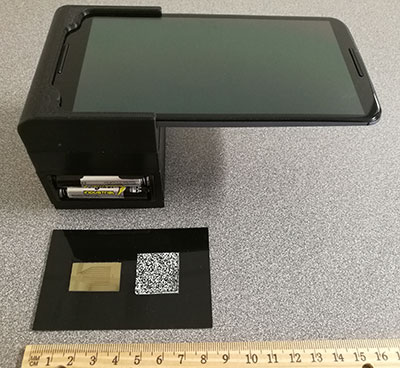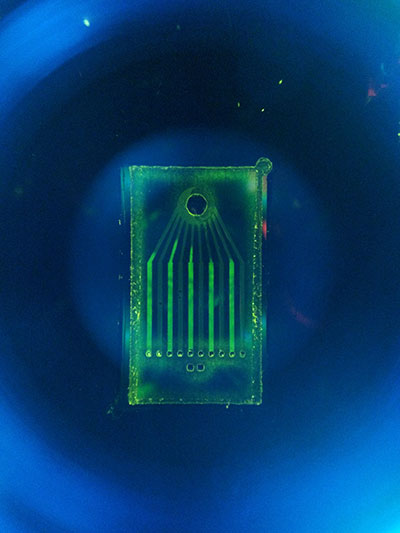
By Marion E. Altieri for EIE
The National Science Foundation (NSF) doesn't give out grant money for research in the arena of animal health very often. Most of the millions of dollars that they distribute are allocated for studies in sciences, including medicine, that will benefit human health and welfare. Lexington equine veterinarian, Dr. David Nash, saw a need in horse health, and set forth to design and deliver PathTracker. The device has the potential to change not only equine health practice, but the future of human medicine, as well.
Dr. Nash and his team of scientists and engineers' PathTracker is a breakthrough so visionary, so insightful, that indeed the possibilities cross between the worlds of equine health and the future of allopathic medicine for humans. This is the sort of research and product that, 50 years ago, was envisioned only by Gene Roddenberry when first he conceived of the Universe through his own imagination via "Star Trek." (Tricorders in "Trek," used for communication and scanning patients for disease, became our smartphones and now—now have developed into Dr. Nash's PathTracker.)
The NSF received the grant application for PathTracker, and saw that this great work will move human medicine forward by leaps and bounds—and thereby granted the team a three-year grant in the amount of $999,950. The figure is astronomical—but the NSF recognizes that this project is not static, rather will advance science in ways that even the inventors may not realize yet. That which began as an advancement in equine medicine will one day become a lifesaver for thousands of humans, all around the world.

The generous grant is giving Dr. Nash and his team the time and tools to perfect their revolutionary technology. The inspiration for this monumental leap forward was a single sick horse at Fair Grounds Race Course. This was a situation of which every player in horse racing became aware, immediately: one single horse presented with symptoms of respiratory infection. He was tested, but the lab was 100 miles away from the track, and it was the Christmas holiday, so diagnosis and the subsequent quarantine were delayed. Delay, in the world of infectious diseases, isn't just an inconvenience: delays can result in deaths.
The diagnosis for that horse was Equine Herpes Virus (EHV-1), and because of the delay, the entire race track had to be quarantined. All states surrounding Louisiana were affected, and the horses who'd traveled to those states. It's impossible to estimate the millions of dollars that were lost or required re-direction, in order to deal with this infection in possibly thousands of horses.
EHV-1 is ubiquitous, as well: it appears in all breeds, both the neurotropic strain and the wild strain. In 10 western states alone, 90 Quarter Horses suffered, and millions of dollars spent as the virus continued to spread throughout the American west.
Dr. Nash saw EHV-1 spreading like wildfire from Louisiana, outward—and thought the fact that current mode of lab testing and diagnosing in the horse world—especially in the case of highly-infectious diseases—was outmoded, and impossibly archaic.
If a horse's broken bone can be x-rayed; a diagnoses and treatment done in the barn, paddock or race track—why couldn't something as small as a virus be contained and tested on the spot, as well?
His vision was born of that simple question: he saw the problem and the need, and then he acted. He assembled his team of 16 engineers and scientists, and began work on a technology that is so small, and enormous in the scope of its work, and its promise. Portable, battery-operated, reliable and durable were the four absolute requirements of the PathTracker as he laid out his vision for his team.

The PathTracker, in essence for those of us who aren't scientists, is a battery-operated device that uses a disposable, one-time-use computer chip to identify bacteria and viruses in fluid samples that are swabbed from horses' nostrils. In approximately 25 minutes the results are displayed on a regular smart phone which has been retrofitted to interface with a portable testing unit. The unit is small enough to be transported anywhere the veterinarian and his/her patient needs.
PathTracker is very similar to the technology that's used to measure insulin in Diabetes patients: within moments, a veterinarian will have the diagnoses in her or his hand: either the horse has EHV-1, or s/he does not.
This is amazing science:
For researchers in the future, PathTracker will allow for real-time epidemiology studies, as outbreaks happen.
“If we can empower this technology, we’re going to allow people to better protect animals and humans, as well…I believe that this is the future of medicine,” Dr. Nash opined.
So far, 10 tests for equine respiratory diseases are being developed, and every one of those tests will be good indicators for human respiratory illnesses. (Dr. Nash pointed out: animals get a disease first [e.g., Avian Flu]. Then, humans come into contact with said animal(s), and the virus or bacteria mutates to affect the new, human host and thereby, the entire human species.)
There's no vaccine so far, to prevent EHV-1 in horses, so the key is rapid and accurate diagnosis: envision a horse who has a fever of unknown origin. The first question should be, "Does the horse have this disease?"
With PathTracker, the test can be administered immediately, and results known within minutes. Then a quarantine can be established, and horsemen notified, within 30 minutes. When time is lost diagnosing a highly-infectious disease, a pandemic always is a possibility. But with the new technology presented by Dr. David Nash and his PathTracker, the first inroad is being made into diagnosing a single horse—and thereby, preventing an epidemic of monstrous, financially-ruinous proportions.

Where does Dr. Nash see the future taking PathTracker? He pointed out that they've proven that chips can be created for symptoms of other unknown conditions (symptoms such as diarrhea, etc.). By empowering highly-trained first responders, veterinarians, doctors to treat and diagnose quickly and efficiently a broad spectrum of diseases, equine mortality rates will lower, and horse racing (just one segment of equine sports) will benefit. Healthy horses mean fewer medical bills in the long-run. The outlay of cash to retrofit smartphones and get the technology of PathTracker will be minimal, compared with the costs of doing equine medical business without contemporary technology. Investing in PathTracker today will result in healthier horses in the future—and owners, trainers whose work pays off in myriad ways, including winning races.
Dr. Nash concluded our conversation with this: “I will eternally be gratefully to the National Science Foundation. The people of the United States…Congress, the White House and the taxpayers should all be very proud of what they’re achieving through this grant.”
Horses have saved the lives or spirits of humans in so many ways, for so many millennia: as soldiers in battle, and working as pack horses, like Sgt. Reckless. As therapy horses, healing broken spirits and bodies of children and soldiers. And now, equines will lead human health studies fully into the 21st Century and beyond, as PathTracker becomes the first line of defense against equine disease, thence, works with doctors and first responders in the realm of allopathic medicine for humans. One horse, one need and one veterinarian with a vision came together to create a technology that will serve and heal millions of horses and humans, for generations to come.

































